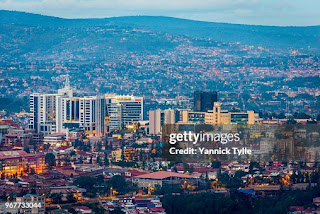Rwanda’s Economic Development: A Journey of Transformation
Introduction
Rwanda, a landlocked country located in East-Central Africa, has undergone one of the most remarkable transformations in modern African history. Once synonymous with conflict and tragedy due to the 1994 genocide, Rwanda is now often hailed as a model of rapid economic growth, social reconstruction, and governance reform. Over the past three decades, the country has taken bold steps toward economic revitalization, poverty reduction, infrastructure development, and technological advancement. This essay explores the journey of Rwanda’s economic development, focusing on the key sectors, policies, challenges, and prospects that have defined its path.
Historical Background
Before analyzing Rwanda’s economic development, it is important to understand the context of its past. In 1994, Rwanda experienced one of the most horrific genocides in human history, in which over 800,000 people, mainly from the Tutsi ethnic group, were killed in just 100 days. The genocide not only led to massive human losses but also destroyed the country's economic infrastructure, institutions, and social cohesion. The gross domestic product (GDP) shrank by more than 50%, foreign investment dried up, and millions were displaced.
Post-genocide, Rwanda faced the enormous challenge of rebuilding from the ashes. The government, led by the Rwandan Patriotic Front (RPF) under President Paul Kagame, embarked on a long-term vision to transform the country into a knowledge-based, middle-income economy.
Vision 2020 and Vision 2050
One of the defining frameworks for Rwanda’s development is Vision 2020, a long-term development plan launched in 2000. Its main goals included:
- Reducing poverty and inequality
- Promoting good governance
- Building human capital
- Achieving sustainable economic growth
- Transitioning from an agrarian to a knowledge-based economy
By 2020, the Rwandan government claimed significant progress in various areas, including improved GDP per capita, better access to education and healthcare, and a reduction in poverty rates.
Following the conclusion of Vision 2020, Vision 2050 was introduced. This plan aims to make Rwanda an upper-middle-income country by 2035 and a high-income country by 2050. It emphasizes innovation, green growth, inclusive development, and economic competitiveness.
Economic Growth and GDP Performance
Since the early 2000s, Rwanda’s economy has recorded impressive growth. The average annual GDP growth rate from 2000 to 2019 was around 7-8%, one of the highest in Sub-Saharan Africa. According to the World Bank, Rwanda’s GDP increased from around $2 billion in 2000 to over $11 billion by 2023.
This growth has been driven by several key factors:
- Sound macroeconomic management
- Investment in infrastructure and human capital
- Political stability and good governance
- Strategic partnerships with donors and international institutions
Despite setbacks due to the COVID-19 pandemic, Rwanda showed resilience and is on a steady path to recovery.
Agriculture and Rural Development
Agriculture remains the backbone of Rwanda’s economy, employing about 60-70% of the population, mainly in subsistence farming. The government has invested heavily in:
- Land consolidation programs
- Irrigation and terracing projects
- Access to improved seeds and fertilizers
- Agricultural extension services
These efforts have helped increase crop yields and food security. Coffee and tea are Rwanda’s main export crops, with the country gaining a reputation for producing high-quality specialty coffee.
However, challenges persist, such as:
- Land fragmentation
- Low mechanization
- Climate change vulnerabilities
To address these, Rwanda is promoting agricultural modernization and value addition through agro-processing industries.
Industrial and Services Sectors
Industrial Sector
Rwanda has been actively promoting industrialization to diversify its economy. The “Made in Rwanda” campaign encourages local production and consumption, aiming to reduce reliance on imports and create jobs. The government has also established Special Economic Zones (SEZs) to attract both domestic and foreign investors.
Key industries include:
- Food and beverage processing
- Construction materials (cement, steel)
- Textiles and garments
- Pharmaceuticals and chemicals
Industrial contribution to GDP has steadily increased, although it still lags behind services and agriculture.
Services Sector
The services sector has emerged as the largest contributor to Rwanda’s GDP, accounting for more than 50%. Key components include:
-
Tourism: Rwanda is known as the "Land of a Thousand Hills" and is famous for gorilla trekking in Volcanoes National Park. Tourism revenues grew significantly before the COVID-19 pandemic, and the country is investing in high-end eco-tourism and conference tourism.
-
Finance: The government has encouraged financial inclusion through mobile banking and microfinance institutions. Kigali is being promoted as a regional financial hub.
-
ICT and Innovation: Rwanda has positioned itself as an emerging technology hub in Africa. The government’s Smart Rwanda Master Plan and investment in broadband infrastructure aim to digitalize services, education, and governance.
Infrastructure Development
One of Rwanda’s most notable achievements is its infrastructure development, which includes:
Transport
- Upgrading and expanding road networks across the country
- Constructing Kigali International Airport and planning the new Bugesera International Airport
- Developing regional rail and road connectivity with neighboring countries (e.g., Uganda, Tanzania)
Energy
- Increasing electricity access from less than 5% in 2000 to over 60% by 2023
- Promoting renewable energy sources such as hydropower, solar, and methane gas from Lake Kivu
Water and Sanitation
- Expansion of clean water supply systems
- Improved sanitation coverage in urban and rural areas
Education and Human Capital
Education is a central pillar of Rwanda’s development strategy. Key reforms and initiatives include:
- Nine-Year Basic Education (9YBE) and later Twelve-Year Basic Education (12YBE) to ensure free, compulsory education
- Expansion of vocational and technical education (TVET)
- Establishment of higher education institutions such as the University of Rwanda and Carnegie Mellon University Africa campus
Rwanda has seen increased literacy rates and school enrollment. However, challenges in education quality and teacher training remain.
Healthcare and Social Development
Rwanda’s health sector has undergone a dramatic transformation:
- Community-based health insurance (Mutuelles de Santé) now covers a majority of the population
- Sharp declines in child and maternal mortality
- Effective campaigns against HIV, malaria, and tuberculosis
- Investment in local pharmaceutical manufacturing
Rwanda is often praised for its effective healthcare system, especially in rural areas.
Governance, Anti-Corruption, and Institutional Reform
One of the distinguishing features of Rwanda’s development has been its focus on good governance and anti-corruption. The government emphasizes:
- Transparency and accountability
- Performance-based contracts (Imihigo)
- Zero tolerance for corruption
As a result, Rwanda consistently ranks among the least corrupt countries in Africa according to Transparency International.
Foreign Investment and Aid
Rwanda has made significant efforts to create a business-friendly environment:
- Streamlined business registration processes
- Investment incentives through the Rwanda Development Board (RDB)
- Legal and regulatory reforms
The country ranks high in the World Bank’s Doing Business indicators. While foreign aid has played an important role, Rwanda aims to become increasingly self-reliant through domestic revenue mobilization and private sector growth.
Challenges and Criticisms
Despite its progress, Rwanda faces several challenges:
Income Inequality and Poverty
While poverty has decreased significantly, inequality remains high, especially between urban and rural areas.
Land Pressure
With a high population density, land scarcity is a growing concern, affecting housing and agriculture.
Political Freedoms
The government has been criticized for limiting political opposition and restricting media freedom, raising concerns about democracy and human rights.
Youth Unemployment
With a young population, Rwanda must create sufficient jobs to meet the growing labor force demands.
External Shocks
Like other developing countries, Rwanda remains vulnerable to external shocks such as global commodity price changes, pandemics, and regional instability.
Rwanda's Green Economy and Climate Goals
Rwanda has emerged as a leader in environmental protection and green growth:
- Banned plastic bags since 2008
- Developed the Green Growth and Climate Resilience Strategy
- Investment in climate-smart agriculture and sustainable cities
The government is also a strong advocate for climate finance and renewable energy development.
Future Outlook
Rwanda’s economic outlook is optimistic but requires careful policy implementation. Key areas for continued growth include:
- Expanding regional trade through the African Continental Free Trade Area (AfCFTA)
- Deepening financial inclusion and digital transformation
- Fostering innovation and entrepreneurship
- Enhancing skills development and higher education
- Strengthening institutional capacity and governance
With its Vision 2050, Rwanda is determined to move beyond aid dependency and build an inclusive, competitive, and sustainable economy.
Conclusion
Rwanda’s journey from a nation devastated by genocide to one of Africa’s fastest-growing economies is a testament to visionary leadership, strategic planning, and national resilience. While challenges remain, the country’s commitment to transformation, innovation, and inclusivity offers valuable lessons for other developing nations. The road ahead is complex, but Rwanda’s determination to shape its own destiny continues to inspire hope across the continent and beyonce.










